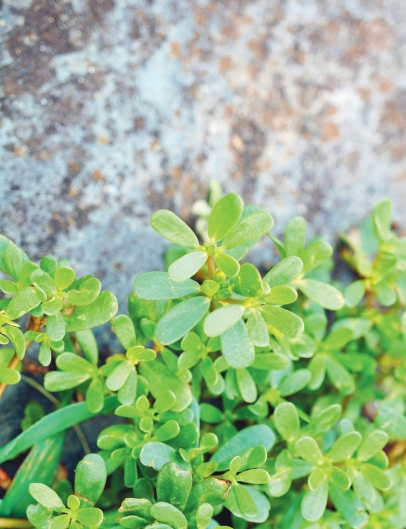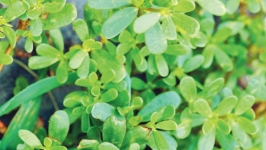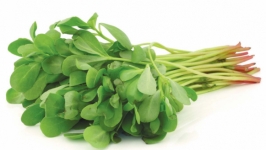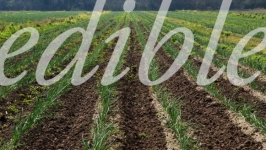Backyard Bounty - Purslane
Purslane is a nutritional powerhouse hiding in plain sight
Acai and avocados may be popular, but it’s nice to know that some superfoods can be found in your own backyard.
Purslane, regarded by some as a common garden weed, is coveted by others as a nutritional powerhouse.
“It’s ubiquitous here in New Jersey, typically found growing in disturbed ground like vegetable gardens, around houses, in farm plots or in the cracks of sidewalks,” says Tama Matsuoka Wong, author and founder of Meadows and More, an organization in Hunterdon County that specializes in food foraging. “However, since it takes up what’s in the soil, you have to be careful where you pick it, avoiding highways or sprayed areas,” she advises.
Purslane is low growing and sprawling. The leaves are small, smooth and plump like a succulent or a cactus—but without the thorns.
“Similarly, it loves dry heat. The hotter it gets, you can almost see it glistening with happiness,” she says.
Wong describes the taste and texture of purslane as being crunchy, lemony and mild.
“There’s a time for picking it when it’s really good, and there’s a time when it’s not,” she says. For Wong, purslane is best when it’s younger. “Mature leaves can have more of a viscous texture. It’s also important to pick before its flower buds start to form, as the taste can get bitter.”
While it’s true that purslane can cover a lot of ground rapidly, Wong suggests that this “weed” may actually benefit your garden.
“Unlike tall weeds that compete for sun and water, purslane provides low, organic ground cover that not only reduces erosion, but helps maintain moisture levels in the soil,” she says, adding that it puts organic matter back into the soil when it dies in the fall.
Beyond soil health, purslane offers abundant nutritional benefits, and has a long history of use.
“It’s been used in the Mediterranean diet and in both Ayurveda and Chinese medicine for centuries,” says Rajesh Kumari, RDN of Overlook Medical Center in Summit. “Growing up in India, it was often a part of our diet.”

“Purslane’s been used in the Mediterranean diet and in both Ayurveda and Chinese medicine for centuries.” —Rajesh Kumari, RDN, Overlook Medical Center
Kumari explains that the fresh, lemony, mild taste of purslane makes it a versatile ingredient in many dishes, making it easy to reap its benefits.
“Purslane is abundant in phytonutrients like flavonoids, which are indicated in the bright colors found in foods like fruits and vegetables,” she says. “Two in particular are called betalain alkaloid pigments and include beta-cyaninsand, which imparts a reddish color, and beta-xanthins, which appears yellow. Studies have shown these phytonutrients have neuroprotective and anti-degenerative effects.”
Kumari explains that these important nutrients are found only in whole foods.
“Most of the nutrients we consume should come from food rather than supplements, and it’s important to know that phytonutrients are part of that equation,” she says.
Healthy eating can sometimes be tricky with hidden sugars. Including purslane in the diet can help.
“Most people are dealing with some level of insulin resistance from over-consuming sugar. Purslane can help improve the sensitivity of insulin to allow the body to use glucose properly again,” says Dr. Nicole Rivera, owner and integrative physician of Integrative Wellness Group in Belmar.
“GLUT-4 is a cell component that’s associated with improving insulin and glucose uptake. Insulin tells cells to use glucose as fuel, and when people lose this sensitivity, sugar doesn’t get used properly and that causes issues in the body,” says Rivera. “Foods like purslane improve the GLUT-4 track location on the plasma membrane, which allows glucose to be properly utilized in cells.”
In addition to benefiting your body’s fuel, purslane is high in omega-3s, which are beneficial to both brain and body.
“Omega-3s benefit the body but are especially important when it comes to brain health,” she says. “Omega-3s from certain sources can cross the blood/brain barrier, and researchers have found that omega-3s from purslane have that ability. Therefore, not only are you getting the benefits of glucose being used properly to fuel the brain, you’re getting the antioxidants from the omega-3s as well,” she says, adding that purslane is rich in other antioxidants like vitamin A and C—and higher in vitamin E than spinach.
While nutritionally valuable, Rivera notes that people with kidney stones should take heed. “If people have kidney stones that are associated with having high levels of oxalates, they may want to avoid purslane,” she says. “If the kidneys are stressed, they can have trouble filtering oxalates, which can build up and lead to kidney stones.” So, as the heat of summer wears on, keep an eye out for purslane—a prolific plant with a plentitude of benefits.
Tips on ways to incorporate purslane into the diet from Tama Matsuoka Wong of Meadows and More, meadowsandmore.com.
Serving: Add chopped purslane leaves to a salad, on top of avocado toast, in place of lettuce on a sandwich or in smoothies.
STORAGE:
If you pick it and it’s hot out, get it cool right away. Keep it in an airtight container in the refrigerator. Purslane can be refrigerated like any other green, and it will last for at least a week, possibly longer.










